|
Unfigured Bass
Unfigured bass, less commonly known as under-figured bass, is a kind of musical notation used during the Baroque music era in Western Classical music (ca. 1600–1750) in which a basso continuo performer playing a chordal instrument (e.g., harpsichord, organ, or lute) improvises a chordal accompaniment from a notated bass line which lacks the guidance of figures indicating which harmonies should be played above the bass note (see figured bass).Lester, Joel (1994), ''Compositional Theory in the Eighteenth Century'', Cambridge: Harvard University Press, pp. 69. Figured bass parts have numbers or accidentals above the bass line which indicate which intervals above the bass should be played in the chord. However, not all basso continuo parts from the Baroque period were figured. History From the earliest days of thoroughbass, composers and copyists have been chastised for providing bass parts without any figures to guide performers. Despite perennial complaints, however, unfigured basse ... [...More Info...] [...Related Items...] OR: [Wikipedia] [Google] [Baidu] |
Musical Notation
Musical notation is any system used to visually represent music. Systems of notation generally represent the elements of a piece of music that are considered important for its performance in the context of a given musical tradition. The process of interpreting musical notation is often referred to as reading music. Distinct methods of notation have been invented throughout history by various cultures. Much information about ancient music notation is fragmentary. Even in the same time frames, different styles of music and different cultures use different music notation methods. For example, classical performers most often use sheet music using staves, time signatures, key signatures, and noteheads for writing and deciphering pieces. But even so, there are far more systems just that, for instance in professional country music, the Nashville Number System is the main method, and for string instruments such as guitar, it is quite common for tablature to be used by player ... [...More Info...] [...Related Items...] OR: [Wikipedia] [Google] [Baidu] |
Baroque Music
Baroque music ( or ) refers to the period or dominant style of Classical music, Western classical music composed from about 1600 to 1750. The Baroque style followed the Renaissance music, Renaissance period, and was followed in turn by the Classical period (music), Classical period after a short transition (the Galant music, galant style). The Baroque period is divided into three major phases: early, middle, and late. Overlapping in time, they are conventionally dated from 1580 to 1650, from 1630 to 1700, and from 1680 to 1750. Baroque music forms a major portion of the "Western art music, classical music" Western canon, canon, and continues to be widely studied, performed, and listened to. The term "baroque" comes from the Portuguese word ''barroco'', meaning "baroque pearl, misshapen pearl". Key List of Baroque composers, composers of the Baroque era include Johann Sebastian Bach, Antonio Vivaldi, George Frideric Handel, Georg Philipp Telemann, Domenico Scarlatti, Claudio Monte ... [...More Info...] [...Related Items...] OR: [Wikipedia] [Google] [Baidu] |
Figured Bass
Figured bass is musical notation in which numerals and symbols appear above or below (or next to) a bass note. The numerals and symbols (often accidental (music), accidentals) indicate interval (music), intervals, chord (music), chords, and non-chord tones that a musician playing piano, harpsichord, organ (music), organ, or lute (or other instruments capable of playing chords) should play in relation to the bass note. Figured bass is closely associated with #Basso continuo, basso continuo: a historically improvised accompaniment used in almost all genres of music in the Baroque music, Baroque period of Classical music ( 1600–1750), though rarely in modern music. Figured bass is also known as thoroughbass. Other systems for Chord (music)#Notation, denoting or representing chords include plain staff notation, used in classical music; Roman numeral analysis, Roman numerals, commonly used in harmonic analysis (music), harmonic analysis; chord letters, sometimes used in modern music ... [...More Info...] [...Related Items...] OR: [Wikipedia] [Google] [Baidu] |
Partimento
A partimento (from the Italian: ''partimento'', plural ''partimenti'') is a sketch (often a bass line), written out on a single staff, whose main purpose is to be a guide for the improvisation ("realization") of a composition at the keyboard. A partimento differs from a basso continuo accompaniment in that it is a basis for a complete composition. Partimenti were central to the training of European musicians from the late 1600s until the early 1800s. They were developed in the Italian conservatories, especially at the music conservatories of Naples, and later at the Paris Conservatory, which emulated the Neapolitan conservatories.The History of Partimenti Monuments of Partimenti Concept |
Baroque
The Baroque ( , , ) is a Western Style (visual arts), style of Baroque architecture, architecture, Baroque music, music, Baroque dance, dance, Baroque painting, painting, Baroque sculpture, sculpture, poetry, and other arts that flourished from the early 17th century until the 1750s. It followed Renaissance art and Mannerism and preceded the Rococo (in the past often referred to as "late Baroque") and Neoclassicism, Neoclassical styles. It was encouraged by the Catholic Church as a means to counter the simplicity and austerity of Protestant architecture, art, and music, though Lutheran art#Baroque period, Lutheran Baroque art developed in parts of Europe as well. The Baroque style used contrast, movement, exuberant detail, deep color, grandeur, and surprise to achieve a sense of awe. The style began at the start of the 17th century in Rome, then spread rapidly to the rest of Italy, France, Spain, and Portugal, then to Austria, southern Germany, Poland and Russia. By the 1730s, i ... [...More Info...] [...Related Items...] OR: [Wikipedia] [Google] [Baidu] |
Purcell Diatonic Chromaticism
Henry Purcell (, rare: ; September 1659 – 21 November 1695) was an English composer of Baroque music, most remembered for his more than 100 songs; a tragic opera, Dido and Aeneas, ''Dido and Aeneas''; and his incidental music to a version of Shakespeare's A Midsummer Night's Dream, ''A Midsummer Night's Dream'' called The Fairy-Queen, ''The Fairy Queen''. Purcell's musical style was uniquely English, although it incorporated Music of Italy#Baroque and Classical, Italian and Music of France#Baroque, French elements. Generally considered among the greatest English opera composers, Purcell has been ranked alongside John Dunstaple and William Byrd in the pantheon of English early music. Life and work Early life Purcell was born in St Ann's Lane, Old Pye Street, Westminster, in 1659. Henry Purcell Senior, whose older brother Thomas Purcell was a musician, was a gentleman of the Chapel Royal and sang at the coronation of King Charles II of England. Henry the elder had three ... [...More Info...] [...Related Items...] OR: [Wikipedia] [Google] [Baidu] |
Solmization
Solmization is a mnemonic system in which a distinct syllable is attributed to each note of a musical scale. Various forms of solmization are in use and have been used throughout the world, but solfège is the most common convention in countries of Western culture. Overview The seven syllables normally used for this practice in English-speaking countries are: do, re, mi, fa, sol, la, and ti (with sharpened notes of di, ri, fi, si, li and flattened notes of ra, me, se, le, te). The system for other Western countries is similar, though si is often used as the final syllable rather than ti. Guido of Arezzo is thought likely to have originated the modern Western system of solmization by introducing the ut–re–mi–fa–so–la syllables, which derived from the initial syllables of each of the first six half-lines of the first stanza of the hymn ''Ut queant laxis''. Giovanni Battista Doni is known for having changed the name of note "Ut" (C), renaming it "Do" (in the "Do Re Mi ... ... [...More Info...] [...Related Items...] OR: [Wikipedia] [Google] [Baidu] |
Harmony
In music, harmony is the concept of combining different sounds in order to create new, distinct musical ideas. Theories of harmony seek to describe or explain the effects created by distinct pitches or tones coinciding with one another; harmonic objects such as chords, textures and tonalities are identified, defined, and categorized in the development of these theories. Harmony is broadly understood to involve both a "vertical" dimension (frequency-space) and a "horizontal" dimension (time-space), and often overlaps with related musical concepts such as melody, timbre, and form. A particular emphasis on harmony is one of the core concepts underlying the theory and practice of Western music. The study of harmony involves the juxtaposition of individual pitches to create chords, and in turn the juxtaposition of chords to create larger chord progressions. The principles of connection that govern these structures have been the subject of centuries worth of theoretical work ... [...More Info...] [...Related Items...] OR: [Wikipedia] [Google] [Baidu] |
Composers
A composer is a person who writes music. The term is especially used to indicate composers of Western classical music, or those who are composers by occupation. Many composers are, or were, also skilled performers of music. Etymology and definition The term is descended from Latin, ''compōnō''; literally "one who puts together". The earliest use of the term in a musical context given by the ''Oxford English Dictionary'' is from Thomas Morley's 1597 ''A Plain and Easy Introduction to Practical Music'', where he says "Some wil be good descanters ..and yet wil be but bad composers". "Composer" is a loose term that generally refers to any person who writes music. More specifically, it is often used to denote people who are composers by occupation, or those who work in the tradition of Western classical music. Writers of exclusively or primarily songs may be called composers, but since the 20th century the terms 'songwriter' or ' singer-songwriter' are more often used, part ... [...More Info...] [...Related Items...] OR: [Wikipedia] [Google] [Baidu] |
Classical Music
Classical music generally refers to the art music of the Western world, considered to be #Relationship to other music traditions, distinct from Western folk music or popular music traditions. It is sometimes distinguished as Western classical music, as the term "classical music" can also be applied to List of classical and art music traditions, non-Western art musics. Classical music is often characterized by formality and complexity in its musical form and Harmony, harmonic organization, particularly with the use of polyphony. Since at least the ninth century, it has been primarily a written tradition, spawning a sophisticated music notation, notational system, as well as accompanying literature in music analysis, analytical, music criticism, critical, Music history, historiographical, musicology, musicological and Philosophy of music, philosophical practices. A foundational component of Western culture, classical music is frequently seen from the perspective of individual or com ... [...More Info...] [...Related Items...] OR: [Wikipedia] [Google] [Baidu] |
Thoroughbass
Figured bass is musical notation in which numerals and symbols appear above or below (or next to) a bass note. The numerals and symbols (often accidentals) indicate intervals, chords, and non-chord tones that a musician playing piano, harpsichord, organ, or lute (or other instruments capable of playing chords) should play in relation to the bass note. Figured bass is closely associated with basso continuo: a historically improvised accompaniment used in almost all genres of music in the Baroque period of Classical music ( 1600–1750), though rarely in modern music. Figured bass is also known as thoroughbass. Other systems for denoting or representing chords include plain staff notation, used in classical music; Roman numerals, commonly used in harmonic analysis; chord letters, sometimes used in modern musicology; the Nashville Number System; and various chord names and symbols used in jazz and popular music (e.g., C Major or simply C; D minor, Dm, or D−; G7, etc.). ... [...More Info...] [...Related Items...] OR: [Wikipedia] [Google] [Baidu] |
Figured Bass
Figured bass is musical notation in which numerals and symbols appear above or below (or next to) a bass note. The numerals and symbols (often accidental (music), accidentals) indicate interval (music), intervals, chord (music), chords, and non-chord tones that a musician playing piano, harpsichord, organ (music), organ, or lute (or other instruments capable of playing chords) should play in relation to the bass note. Figured bass is closely associated with #Basso continuo, basso continuo: a historically improvised accompaniment used in almost all genres of music in the Baroque music, Baroque period of Classical music ( 1600–1750), though rarely in modern music. Figured bass is also known as thoroughbass. Other systems for Chord (music)#Notation, denoting or representing chords include plain staff notation, used in classical music; Roman numeral analysis, Roman numerals, commonly used in harmonic analysis (music), harmonic analysis; chord letters, sometimes used in modern music ... [...More Info...] [...Related Items...] OR: [Wikipedia] [Google] [Baidu] |










